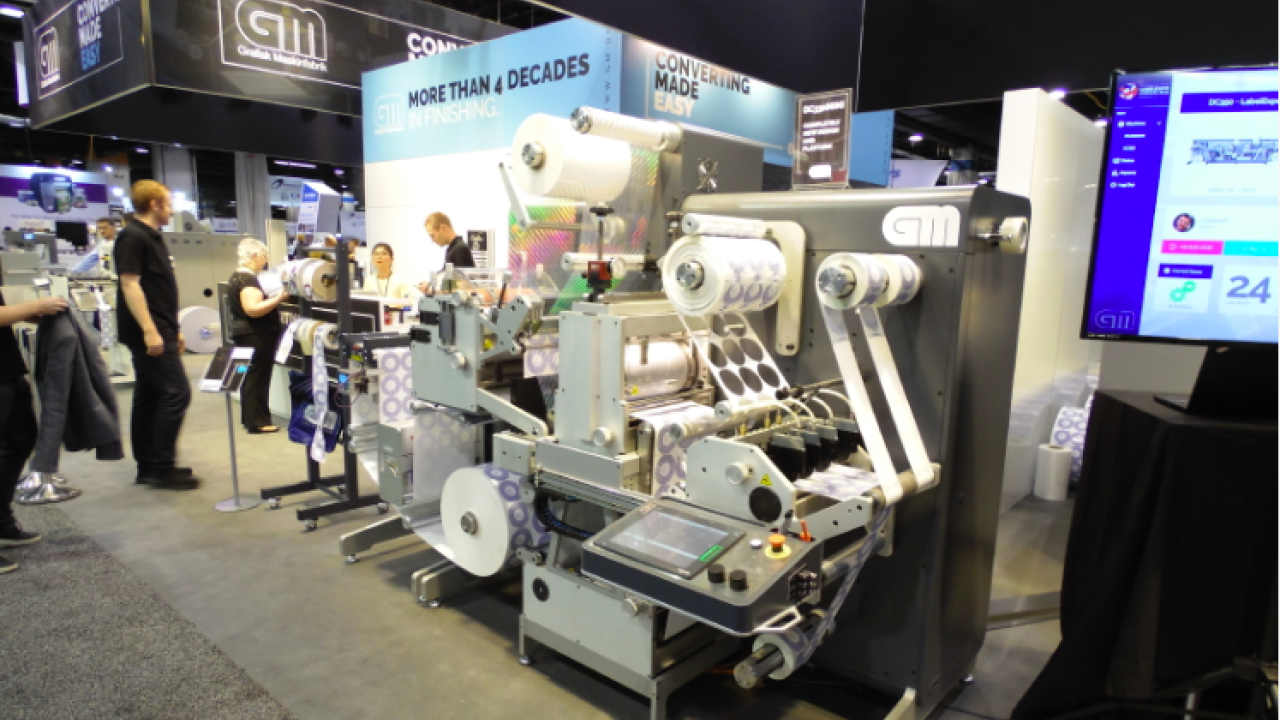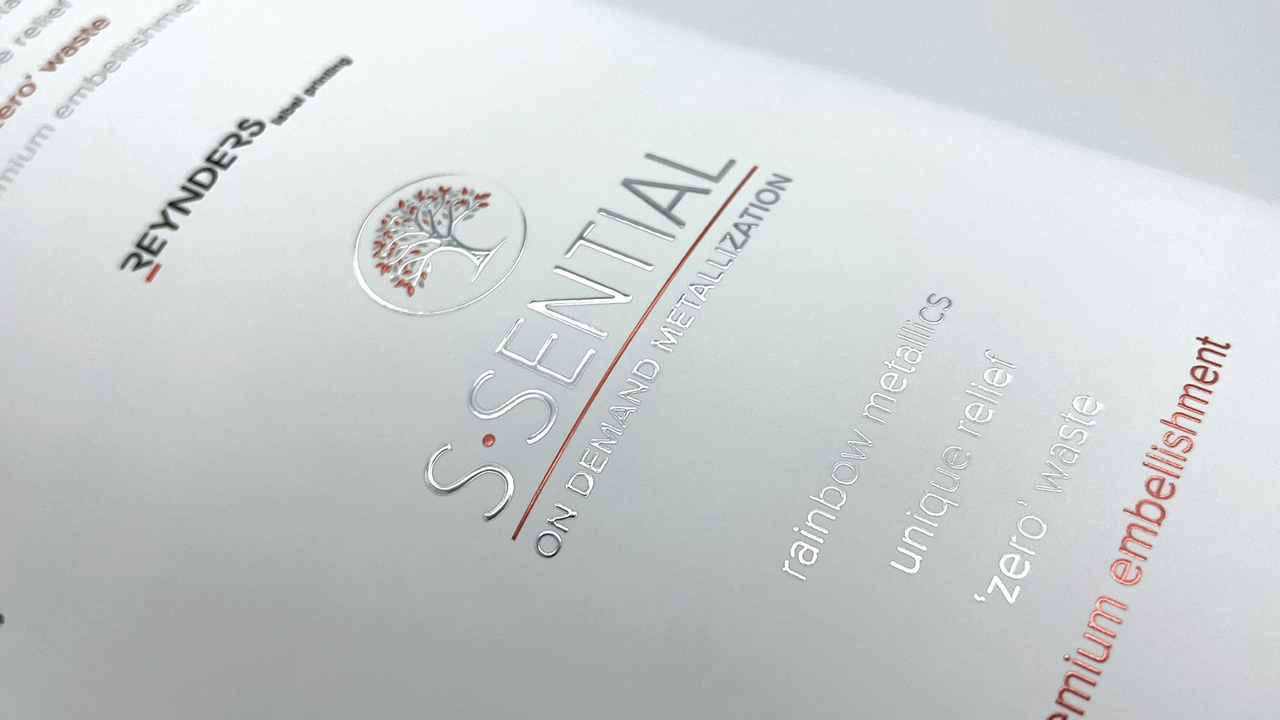Labelexpo highlights added-value converting

From ETI’s upgraded Cohesio line, the SEI Laser Labelmaster and DPR’s new desktop Virgo digital label finishing systems, to Fix-a-Form’s AF500 next-generation leaflet label machine, such systems are designed to offer the latest tools for high speed, high quality label production of all sorts.
The ETI Cohesio on show at Labelexpo Americas 2018 has been purchased by Heartland Label Printers to support the continued growth of its pressure-sensitive label business, while also being capable of producing linerless label products. Laser engraving, micro-piercing and coding on the SEI Laser Labelmaster allow security elements and variable data to be added to labels. Berhalter’s Label-light die-cutting tool for IML and polyester labels combines favorable tool costs and short lead times, coupled with the benefits of flatbed die-cutting, such as print-to-die registration and handling properties. The Enprom eRS 60 for heat shrink sleeve seaming converts a plastic sheet into a single sleeve label or multiple sleeve for promotional packages. It uses solvent-based welding that once placed on the final product conforms to the shape of the container and does not open when heat is applied.
Further developments have seen automation become increasingly prevalent, as with Grafotronic’s Q-Load automatic side-loading system, and wider widths are now commonplace – AB Graphic has a growing finishing portfolio for mid web digital production, for example, while AF500 builds on Fix-a-Form’s AF350 model, handling web widths of 70-500mm for leaflet labels from 20-280mm long.
Embellishment
One of the biggest drivers of developments in finishing is the desire to add decorative details and features.
Pantec sees foil stamping as a popular and effective method of embellishment in the wine and spirits market. Demonstration of production of a three-foil rum label by Pantec at Labelexpo Americas 2018 gave a glimpse into what can be achieved through the use of its Rhino IIS 410 flatbed hot foil embossing system. Rhino IIS operates with a maximum embossing force of 60 tons, up to 30,000 strokes an hour and can accommodate a stamping tool up to 410 x 410mm. A multistroke process allows up to four foils to be applied to one label in one production run.
And while foiling is increasingly a standard finish for high quality labels, advances by Pantec in micro- and nano-embossing, as well as lenses, raise the bar higher. These create holographic and spatial effects directly on labels and packaging. ‘Luxury label printing, especially flatbed stamping, is an art, leaving a lot of space for creativity,’ explains Pantec CEO Reinhard Braun.
Kromex from Demak is a patented technology for in-house manufacturing of 3D emblems and decals with chrome external finishing. Kromex can be used for cosmetics packaging, as well as in automotive, car aftermarket, motorcycle, farm tractor, marine, home appliance and sport emblem applications. Kromex emblems and logos are flexible and easily applied to both flat or curved surfaces. Special effects can be added using satin, matte and colored finishing, or even with the use of PU resins on top.
Embellishment has not escaped digitalization, either. The MGI JETvarnish 3DW, as shown by Konica Minolta, allows label printers to go digital for spot UV coating and embossed hot foiling without dies, screens or tooling on narrow webs up to 420mm. The JETvarnish 3DW is designed for both 2D (flat)/3D embossed spot coating over flexo, offset or digital web-fed printed output. Hot foiling can be added with metallic and colored foils to embellish label designs.
Through a Digicon Series 3 integrated with a new Jetfx digital embellishment module, AB Graphic has presented an off-line, fully digital system for creating varnish and foil effects. The embellishment module features two inkjet bars and overlamination to allow for cold foil effects.
HP Indigo introduced GEM, its one-pass digital embellishment system, last year but it has now been extended with compatibility with foils from Kurz and K Laser. ILS has now been named as the first in the US to install GEM, which it will run in-line with an HP Indigo 6900 digital press. Jay Dollries, ILS president and CEO, proclaimed: ‘This latest cutting-edge innovation allows our business to be dynamic and responsive to deliver a broad range applications and creative capabilities. We are not limited to the embellishment being the same on every label, with the GEM also enabling variable embellishments.’
Compact and powerful
Systems are then being engineered to offer such capabilities on a small footprint. Spartanics’ Laser Lite is a compact laser converting system integrated with the company’s Fastline AI plug-in die line creation software and workflow application. It comes as standard with an unwinder, rewinder, scrap rewinder and laser die-cutting. Additional options include web guiding, self-wound laminate, a 250W, 10.2 micron carbon dioxide laser high speed option, barcode reading and knife slitting.
Grafisk Maskinfabrik (GM) launched the fourth generation of its DC330Mini converting machine. Redesigned with the help of an industrial engineer, this features new electronics, a newly-designed control panel and an updated user interface, which gives the operator a graphical representation of the machine as installed.
New from DPR are the VRG22PL and VRG14PL desktop digital label finishing systems. These build on its existing Virgo compact desktop finishing system to provide an option for label finishing over an even smaller footprint and at a lower investment cost.
The latest version of the Martin Automatic MBS splicer is claimed to have the smallest in-line footprint on the market. This is made possible by an integrated 90-degree turnbar.
Mühlbauer’s PL light is an RFID personalization system designed for low to medium volumes with a throughput of up to 18,000 units per hour. The process includes UHF chip encoding as well as printing variable data for graphical personalization. A maximum web width of 110mm can be processed. A modular design enables other processes to be integrated on request.
Modular
The ability to upgrade such systems with different modules is a cornerstone of finishing and converting equipment suppliers.
Sheeting, foiling, embossing, laser die-cutting and conveyor modules are upgrades that can be made to Delta ModTech’s systems. Further, Intelli-mod, as demonstrated on a Spectrum modular finishing machine at Labelexpo Americas 2018, allows complete control over each module and part of the converting process. Using proprietary HMI software and the use of individual servo motors, each die station and winding station can be adjusted independently, on the fly.
A Cartes Gemini 360 in the configuration GE362ZL R-L highlights how customers can combine modules according to their needs. This includes flexo varnishing and laser converting. A new laser version in right to left configuration features Cartes’ ILC module, which makes it possible to die-cut dark printed labels without white edges.
Rotocontrol’s DT Series is a fully modular line, with a 340 model shown at Labelexpo Americas 2018 for finishing digitally pre-printed rolls of labels.
Brotech’s SDF Plus modular label converting and finishing system features flatbed hot stamping (using a patented 90-degree rotatable stamping head), flatbed screen printing and flatbed die-cutting. It can be upgraded with a semi-rotary/rotary flexo printing unit, rotary die-cutting unit, IML/sheeting collection unit and other modules for efficient processing of digitally printed labels.
Digital-driven
Many of the finishing technologies on show at Labelexpo Americas 2018 were presented for the growing need to convert digitally printed labels and packaging.
Debuting in the region with is new-look portfolio, Grafotronic showed a DCL2 digital finishing machine equipped with a flexo unit for high speed spot/full varnish, WiFi-slitting automatic knife positioning system and non-stop system for continuous running. It also featured GigaFast, its 160m/min semi-rotary die station.
The Prati Digifast One digital finishing system features semi-rotary printing and die-cutting at up to 90m/min in combination. Accuracy is recorded at ±0.10mm and set-up times are as short as eight minutes.
‘With the growing success of digital color printing and shorter runs there is demand for reliable, easy to set-up and affordable high-speed finishing,’ notes Dennis Kallaher, vice president of sales at TCS Digital Solutions. This has seen it develop Diamond, a desktop production class, semi-rotary label finishing system intended for commercial and in-plant printing operations.
Rotoflex launched the DF3 configurable off-line digital finishing and converting machine. It offers an array of off-line decoration and finishing for digital and hybrid printing. These include full and semi-rotary die-cutting lamination, foil decoration, rotary screen, waste removal and turnbars. It operates at up to 1000ft/min.
Demand for finishing of digitally printed packaging is growing too. HP Indigo’s Pack Ready technology is now available in multiple guises, notably Pack Ready Lamination. This technology allows immediate time-to-market for flexible packaging and the creation of high-quality, high-performance laminates for HP Indigo digitally printed flexible packaging without the use of adhesives.
AB Graphic’s new ILC760 in-line coating machine debuted at Labelexpo Americas 2018 on the HP Indigo stand, where it was shown integrated with an HP Indigo 20000 digital press. ILC760 supports both water-based and UV coating. It supplements the Digicon 3000 in AB Graphic’s growing finishing portfolio for mid web digital production.
Tony Bell, sales director at AB Graphic, explained: ‘The demand for digitally printed packaging is growing well beyond the pressure-sensitive label market into areas such as sleeves, IML and various flexible packaging applications.’
Stay up to date
Subscribe to the free Label News newsletter and receive the latest content every week. We'll never share your email address.


